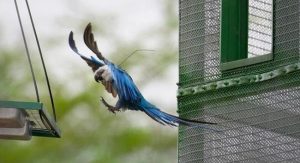The Spix’s macaw (Cyanopsitta spixii), extinct in the wild for more than 20 years, now flies again in its natural habitat in Brazil. It was officially released on Saturday, June 11, 2022.

It is said that scientists and parrot breeders worldwide have been working towards this day for decades, a development described as a unique project as well as a symbolic success for wildlife conservation.
Ten years ago, ICMBio, the Chico Mendes Institute for Biodiversity Conservation in Brazil, established the “Spix’s Macaw Action Plan” to increase the parrot’s captive population and restore its natural habitat to promote its reintroduction in the wild. For this purpose, all legal Spix’s macaw populations were united in the state-of-the-art breeding facility of the German wildlife conservation association, the Association for the Conservation of Threatened Parrots e.V. (ACTP) in Berlin.
Marcos Venancio, Director of Biodiversity Research, Assessment, and Monitoring at ICMBio, declared: “The Spix’s macaw population in captivity was only 5% in national territory and 89% in the ACTP maintainer. Therefore, we had a mutual interest and ACTP in joining measures to repatriate Spix’s macaws to Brazil and reintroduce them to the natural environment. This resulted in the technical cooperation agreement between ICMBio and ACTP in 2019.”
With the support of various partners, the “Spix’s Macaw Release Project” evolved into a remarkable wildlife conservation programme. With ambitious teamwork, the aim was finally achieved: the initially vanishingly small population of 55 Spix’s macaws in 2000 was increased to the significant number of 261 healthy parrots.
In March 2020, 52 Spix’s macaws were moved to the breeding and release enclosure built by the ACTP and its partners, especially for this project, the “Spix’s Macaw Release Centre” near the town of Curaçá, to the Caatinga, which Brazilian government had declared a protected area two years earlier. Since then, some parrots have been prepared for release into the wild.
Today, the time has finally come: The first eight macaws are leaving the large release aviary of the Centre and flying into nature in Brazil for the first time. A further 12 birds will follow later this year – a moment that the inhabitants of the Caatinga have been looking forward to with great anticipation for years.
A dream is also said to be coming true for Dr. Cromwell Purchase, Director of ACTP Brazil, who said: “After years of giving everything to this project, we are finally at the point where we bring the Spix’s macaws voice back to the Caatinga.”
This long-term international joint project is seen as an opportunity for humans and animals – the “Spix’s Macaw Release Project” thus promotes the repopulation of the parrots and the lives of many inhabitants of this area. The wildlife conservation project is part of a more extensive community programme supporting biodiversity and organic agriculture.
The approximately 7,500 pupils of the local schools are taught about the project and thus sensitised to the topics of wildlife conservation and ecotourism. Local environmental protection and social work organisations work with community representatives here.
“It was a long rocky path to get here that would have not been possible without the excellent teamwork at ACTP and the support of our partners. Seeing how excited the people are here in Brazil regarding the return of their Spix’s macaw and their gratitude and appreciation for our work means a lot to me. Today we bring the Spix’s macaw back to nature!” said Martin Guth, Director ACTP Germany.
The Spix’s macaw has been renowned worldwide since the film “Rio.” The animal was discovered around 200 years ago by the German naturalist Johann Baptist von Spix. Its original home is the Brazilian Caatinga, a Savannah landscape located in the northeastern federal state of Bahia. Today, the Spix’s macaw is one of the rarest birds in the world.
Due to its distinctive blue colour, it became a popular target for poachers and collectors worldwide in the past. Man’s destruction of its natural habitat and the illegal trade caused the population in the wild to decline steadily in the 1980s and 1990s until, in 1990, only one bird was living in the wild.
Ten years later, the species was officially declared extinct in the wild by the International Union for Conservation of Nature (IUCN). Only a minimal number of privately-owned birds worldwide had survived. Breeding seemed impossible as the genetic pool was too limited to maintain a healthy genetic diversity in such a small population.
